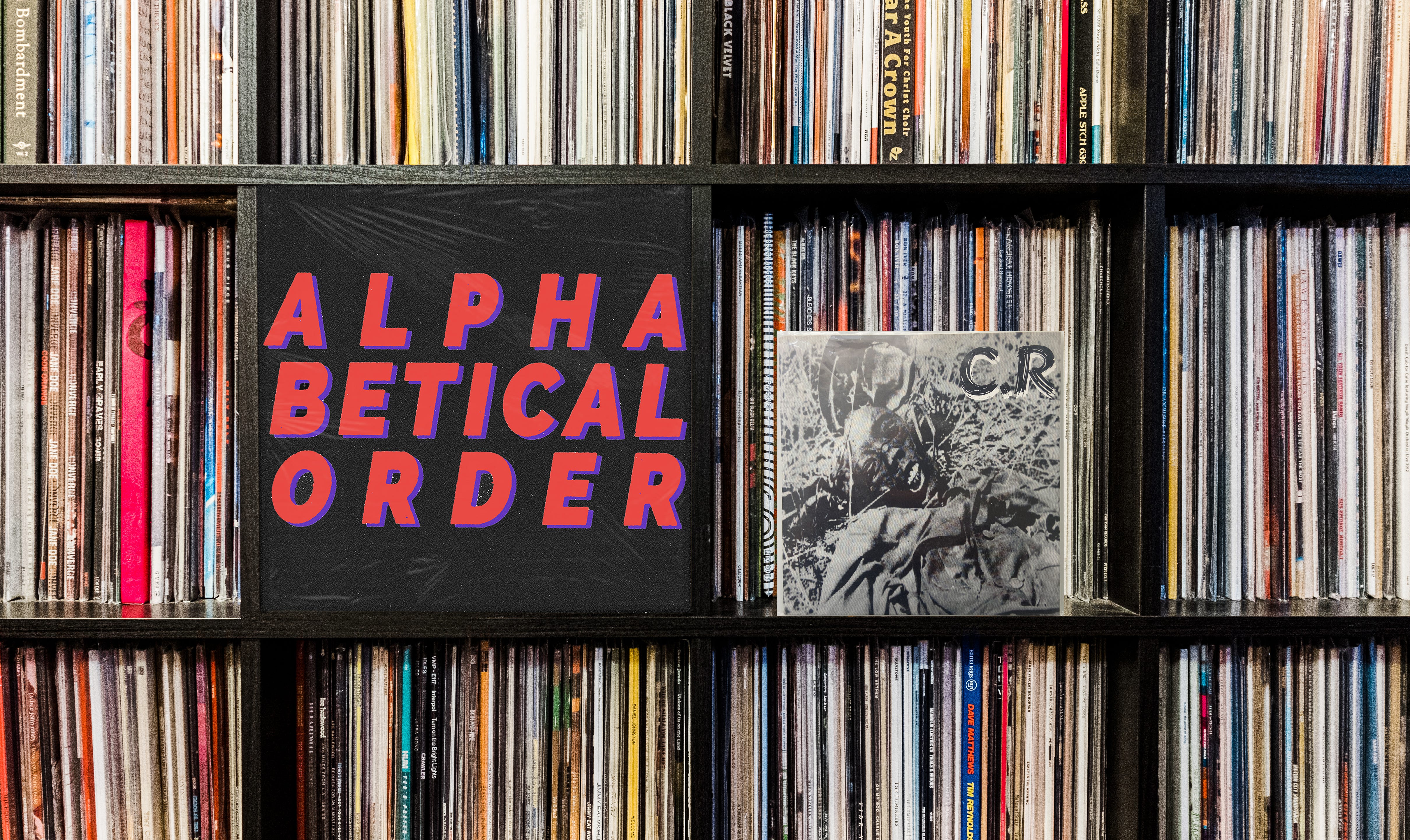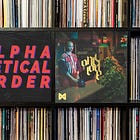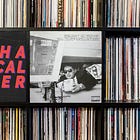Alphabetical Order: C.R. - 'Self-Titled'
A local band can change your entire life.
Welcome to ZERO CRED, the only music newsletter ever to exist. Alphabetical Order is a project where I go through my record collection and try to make sense of my life, from A to Z.
I wish I had the confidence of those guys who peruse jazz LPs at record stores. I dream of flipping through Coltrane and Miles Davis records and knowing what I’m looking at. Not just jazz. I fantasize about being knowledgeable about all kinds of genres. About classical and electronic and reggae. If only I could poke around these sections and be able to pull out the rare or valuable finds. Then I could drop a fat stack of vinyl on the counter and impress the cashier with my eclectic tastes.
But who am I kidding? I know myself and I accept my limitations. Which is why when I walk into a record store, I head straight to the hardcore/punk seven-inches. Here is where I am king. A veritable connoisseur of one incredibly niche section. I can predict with alarming accuracy what will be in these bins at any given store and what each is worth. Show me a Bing Crosby record and I’ll shrug my shoulders, but I can spot a Pinhead Gunpowder record from twenty yards away and tell you whether it’s the Lookout Records original or the 2021 repress.
It’s usually the same old finds and today’s search is no different. American Nightmare, Aus Rotten, and Agnostic Front in the A section. Blacklisted, Bane, and Boilermaker in B. I start flipping through C and it’s more of the usual. Converge, Coliseum, Chain of Strength. Then I land on one that makes me stop.
The C.R. seven-inch.
I come across this record maybe once a year and it baffles me every time. How did this little EP released in 1996 in my hometown of Staten Island, New York, make it all the way here to this Los Angeles record shop? That’s a nearly 3,000-mile, 30-year journey. Like finding a piece of the Titanic in Topeka. I look at the black and white cover of a corpse’s decaying face and imagine how it arrived here. Did someone move across the country with it before deciding they didn’t want it anymore? Did the record label ship a mailorder copy way back in the 90s to an L.A. collector who died recently?
I can come up with a million scenarios but how it got here doesn’t really matter. I’m going to do what I do every time I find this record in the wild.
I bring it to the cashier and open my wallet. The little orange sticker in the corner says $4.99. My entire youth for under five bucks. The songs that rearranged my brain for only four dollars and change. I take the record home and add it to the others.
When I was 14 I found cool music the way most 14-year-olds did in the 90s: mixtapes. A friend would get their hands on an album from an older brother or a cousin or a neighbor and was duty bound to copy it and pass a tape off to the next person. This is how I got a Maxwell cassette that I listened to until it broke.
On one side was Fugazi’s 13 Songs. On the other was Cringer’s Karin. All I knew was what was written on the label. I didn’t realize one was the most respected independent band of their generation and the other was a little pop punk band from Hawaii that most people had never heard of. That’s one of the joys of a mixtape. No context, just music. Completely blind discovery.
Crammed into the remaining space of this cassette were ten minutes of mystery music. It didn’t sound like Fugazi or Cringer or anything I’d ever heard. The first time I pressed play, I heard a poppy and joyous instrumental jam. A song you could bounce around your room to with a smile on your face. But after a minute of this, the euphoria was abruptly cut off by a sharp and violent scream like a switch had been flipped. The next nine minutes were absolutely punishing. A loud and fast assault that pummeled me from every direction.
These ten songs stopped me dead. The only thing I’d ever heard that came close to it was Minor Threat whose speed and aggression appealed to my teenage angst. But this was different. Today, with a broader knowledge of the nuances of hardcore, I might describe it as power violence, but at the time all I understood was the force of it. It hit like a mallet, which, ironically, was the name of the first track.
The music was heavy and destructive but there was also a kindness and light-hearted positivity to it. One song was called “Popeye” and the lyrics were, in their entirety, “I am what I am. I will never divide me from myself.” Another crushing song ended with a sample of Kermit the Frog saying, “I’ve got a dream too. But it’s about singing and dancing and making people happy. That’s the kind of dream that gets better with the more people you share it with. I found a whole bunch of friends who have the same dream and it kind of makes us like a family.”
The band was called C.R. and they might as well have been from outer space. But as I would soon find out, the members were not from Mars. They actually lived right nearby. I could barely comprehend that local guys were making music like this. I wanted to know everything. I wanted to know where they recorded it and how they made their records and how many copies there were and what they were screaming about. I wanted to know where this was all happening.
My quest to find out more about C.R. is what led me to my first show, at a local hole in the wall on Staten Island called The Joint. It is not lost on me that the first place I saw a DIY show as a teenager shares a name with the chiropractic office I currently frequent to treat my bad back.
This is where I first experienced hardcore.


The most accurate depiction of the experience of walking into a DIY show for the first time was not written in any punk history book. Most movies get it wrong too. It was actually comedian Chris Gethard who really nailed it. In his memoir, Lose Well, he wrote about being dumbfounded in front of a merch table at a New Jersey church basement show as a 13-year-old. He stared in awe at the handmade shirts and stickers. Then he picked up a demo tape and T-shirt and asked the band member selling them, “Who let you do this?”
Who let you do this?
I think about that line all the time. What a beautifully concise capturing of the instant a person’s brain short circuits and gets completely rewired. That’s the a-ha! moment that everyone who finds punk and hardcore has—that there is an entire society that exists outside the mainstream. This society has its own economy and its own culture and its own rules. There is no adult in the room. There is no need to ask permission because there’s no one to even ask permission of. You can just do what you want and make what you want and no one is really going to stop you.
The music at my first show was a revelation too. I’d always assumed that rock music had to be played for either 10,000 people in an arena or for nobody in a garage. I didn’t realize there could be an in-between of a hundred people. The stage was just a short platform a few inches off the ground. There was no separation between audience and performer. Everyone was on the same level.
But as egalitarian as it was, C.R. were the kings of this scene. Their names were always at the top of the five-band bills on flyers. They had records available at the local music store and had done a few short tours and had played CBGB in the city. They’d spread the word of Staten Island hardcore around the country and for that they were local heroes. They set the trends that were followed by other bands.
C.R.’s singer went by the name Bricks and he was an absolute madman on stage. An indefatigable blur of tattoos and lean muscle. Bouncing off the walls and spiraling in the air like a gymnast. His voice hit like a thousand haymakers. Sometimes he donned a full tuxedo. Sometimes he got completely naked. At 14, every band is the best band you’ve ever seen and every singer is the greatest performer ever. But I’ve probably seen a thousand hardcore bands since then and I still think Bricks is the best to ever do it.
It wasn’t just Bricks’ energy or the way he carried himself. It was what he said when he held the microphone in his hands. He spoke out against violence towards women. He mocked religious hypocrisy. He talked about acceptance and embracing our differences. And he said it all with a thick Staten Island accent. He would say, “This next sawng is for anyone havin’ a hahd time being accepted for who you awhr.”
I realize this all sounds like Hardcore Frontman Stange Banter 101, but Staten Island is a working-class slice of New York City that is largely populated by meatheads and misogynists and loudmouth tough guys. It’s the only borough of New York City that swings red during elections. So to grow up there and hear these messages of unity and empathy spoken in my native language was a totally radical concept. Bricks was just some guy who worked for the telephone company. He climbed phone poles for a living. But I hung on his every word.
I wouldn’t learn this until years later, but C.R. stood for Compassionate Revolution, and that was the message they spread. Benevolence through an unrelenting show of force. Sometimes I’d spot a person on the train or at the mall with a C.R. patch on their backpack and it was like we were all part of this movement. Like we, as Kermit said, were like a family that shared the same dream.
This was the first and most important lesson I learned about hardcore and, really, life. It taught me at this young age that trying to change all the problems of the world is a fool’s errand that will drive you insane. But you can create a ripple in your small community and watch how far it spreads.
Unfortunately, C.R. was not long for this world. Just as I was discovering them, they were calling it a day, ending their run unceremoniously on stage one night in 1998. C.R. was only around for three years. They released one album and a couple of EPs. 46 songs and 46 minutes were all they left behind. But their legend reverberated through Shaolin for years to come.
But this isn’t really about C.R.
Everyone who found hardcore at a young age has their own C.R., a local band that they treated with disproportionate reverence. A band whose members were only a few years older than they were but might as well have been gods. A band that provided the blueprint for what the genre was about. C.R. was that band for me.
It’s harder for me to be excited by new things these days. I get stuck in traps where I feel like I’ve seen and heard it all. There are a lot of things I miss from my youth. Not having chronic back pain from sleeping the wrong way being at the top of the list. But what I miss most is that feeling of hearing something for the first time and having it open up a new way of looking at music or the world or myself. Those ten minutes of music mapped out the rest of my life. I still get that same feeling every time I listen to it. I still want to create ripples.
The reason I buy the C.R. seven-inch every time I find it is because I worry about the future of these kinds of things. I don’t trust that the internet will preserve the work of our local legends forever. And maybe that’s how it should be. Maybe the things we love should inspire new culture that comes along and paints over the old culture. But I can’t help but try to keep it alive for a little longer.
So whenever I find a copy of the C.R. seven-inch, I feel a responsibility to keep an important piece of history circulating for as long as I can. Usually I give the record to a friend who might appreciate it or mail it to a reader who writes me a kind message.
I want to spread the feeling I first got as a 14 year old far and wide. I want to promote the legacy of the four guys who put Staten Island hardcore on the map. And I want as many people as possible to know that there is room in this world for a compassionate revolution.
True to my word, I am giving away a copy of the C.R. seven-inch to one of my paid subscribers. If you have a paid subscription, look for that in this Sunday’s column. If you don’t have a paid subscription, upgrade today!
MORE READING
FOLLOW ME
Real life: PO Box 11352, Glendale, CA 91226
Shop my merch store for books, zines, records, etc.
Get my book SELLOUT at Bookshop, Barnes & Noble, or Amazon.






Nicely said. For what it’s worth I owned the CR 7” and mail ordered it from Wellington, New Zealand. So that’s another 14 hour flight from LA
CR were great. And like you said, they were guys from the neighborhood. Seeing people on stage who looked just like family friends making this amazing noise was a gamechanger. DIY indeed.